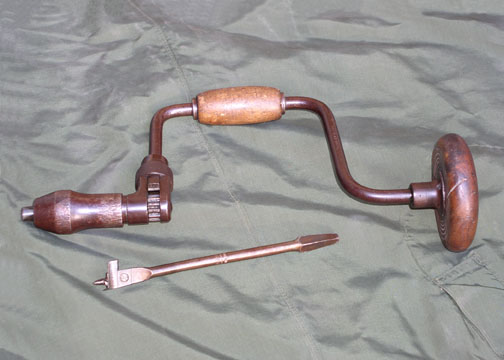
carpenter's brace (artifact #22)
CARPENTER'S BRACE
[from the Franklin collection] Our '39 Chevy exhibited the tell-tale fluttering exhaust and loss of power caused by burned valves. Albert treated the gas with Casite in case it was only carbon. That made it worse, so he took the car to a garage in Fayetteville for a valve job. All his mechanic's tools, in a large wooden tray, were stolen from the trunk. But the carpenter's tools, including this brace, escaped.
This wood-drilling brace was in use from my earliest recollection. Its age is unknown. MOHAWK MADE IN USA is stamped into the crank shaft. The palm swell is on a flat ball-bearing race and is black walnut, probably a replacement made by Albert. The crank handle is bored through to turn freely on the crank with the wood bearing directly on metal. It is hardwood, maybe hickory, with an unusual assembly method — the wooden blank is center bored first and lathe-turned to shape. It is then split into two halves (or sawed with a very thin blade) and glued back together around the
shaft. In my experience, "carpenter's" glue is really good stuff, sold as a powder and mixed with water.
The two-jaw chuck is shaped to take square-shank auger drills. It grips a round shank poorly. This accounts for the abuse of the serration on the chuck body and the knurl on the chuck collar, which are nearly obliterated. Fortunately, the chuck screws onto its shaft with a square-cut Acme thread that withstands over tightening. There is a reversible ratchet mechanism with full-lock facility. Mouse-trap springs open the chuck jaws and provide ratchet action of two dogs against the ratchet teeth. The springs retain good temper.
The drill bit is illustrated only as an example of a square shank. This one is adjustable in size from about 1/4" to 1/2" radius (1" diameter). Dad called this an expansion drill. The tap screw helps control wobble of the single cutting blade. There is no auger (the characteristic spiral of an auger drill) to keep chips cleared out of the hole while drilling.
The tool was indispensable in the electrical wiring of a lot of houses. The R.E.A.
came to our neck of the woods in Arkansas in 1948. It nearly didn't come
then because so few could afford to sign up. Albert Franklin wired many of the houses that signed up, state code and everything. He did the work for parts cost to help as many sign up as possible. He claimed he was sick of buying batteries for the radio. The brace was used in the modification of our 2-wheel trailer so it could be horse drawn. Other applications include drilling bolt holes where nails would not be strong enough, such as the assembly of my work benches. I have used it to start the shapes to be cut into furniture. Plant the palm swell into your sternum, bear your full weight, and drill some serious holes.
Bill F.(2003)

